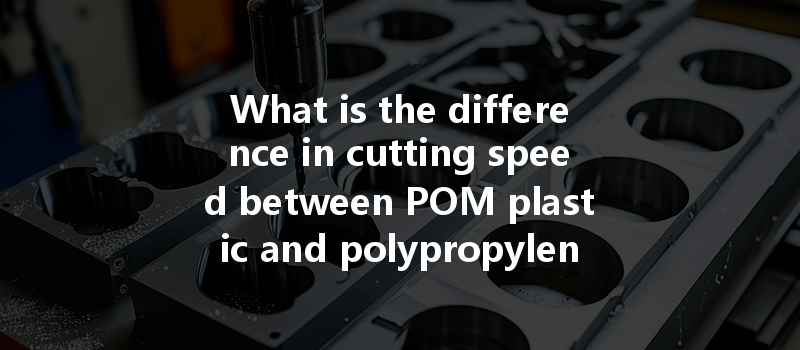*
In a rapidly evolving industrial landscape, the precision and efficiency of CNC machining processes are paramount to success. As manufacturers increasingly turn to various materials to meet specific application needs, understanding the cutting characteristics of different materials becomes crucial. Two common thermoplastics utilized in CNC machining are Polyoxymethylene (POM) and Polypropylene (PP). Each possesses distinct properties that influence their performance metrics, particularly cutting speed during machining operations.
In this article, we will delve deep into the intricacies of cutting speeds associated with POM and PP plastic in CNC machining. We’ll examine the material properties, factors affecting cutting speed, best practices for machining each type, and conclude with insights that can empower manufacturers and engineers in making informed material choices.
Understanding POM and PP: Material Properties
Polyoxymethylene, commonly known as acetal or polyacetal, is a high-performance engineering thermoplastic. Renowned for its rigidity, excellent dimensional stability, and low friction, POM finds a range of applications in various sectors, including automotive, aerospace, and consumer goods.
Key Properties of POM:
Polypropylene, on the other hand, is a lightweight thermoplastic known for its chemical resistance and cost-effectiveness. It offers decent mechanical properties and is widely used in packaging, automotive components, and medical applications.
Key Properties of PP:
Summary
POM and PP cater to different engineering needs, driven by their inherent properties. Understanding these materials in terms of mechanical strength, thermal stability, and cost allows businesses to choose the right plastic for their manufacturing processes.
Factors Affecting Cutting Speed in CNC Machining
Before diving into the cutting speeds of POM and PP, it’s vital to recognize several factors that influence cutting speed during CNC machining:
Cutting Speed Dynamics
Understanding the cutting speed for POM and PP involves analyzing the relationship between these factors and their respective performance metrics.
Cutting Speed of POM in CNC Machining
The recommended cutting speed for machining POM typically ranges between 200 to 300 m/min (meters per minute). Factors such as tool type, diameter, and machine rigidity can influence this range.
High-speed steel (HSS) tools or carbide-tipped tools are most commonly used for machining POM. Opting for appropriate cutting tools can extend tool life and maintain higher cutting speeds.

The feed rate for POM processing should generally be kept within 0.5 to 1 mm/rev, depending on the specific CNC machine settings and desired surface finish. An optimal feed rate ensures efficient material removal while reducing the stress on cutting tools.
Using a coolant is essential when machining POM, as it minimizes thermal buildup and prevents melting, ensuring consistent cutting speeds and preventing the deformation of the finished product.
Cutting Speed of Polypropylene in CNC Machining
Polypropylene tends to require higher cutting speeds than POM, with ranges from 300 to 500 m/min. The lightweight nature of PP allows for faster machining, enhancing production rates in high-volume scenarios.
For cutting PP, high-speed steels or special-purpose polymer machining tools are recommended. Coated tools can also improve wear resistance and cutting performance.
When machining PP, feed rates of approximately 1 to 2 mm/rev tend to be effective. The higher feed rates help maintain the robustness of the cutting process and optimize productivity.
While coolant usage is less critical for PP compared to POM, it can still aid in dust control during machining. Therefore, using air blowers or mist lubrication could effectively maintain cleaning while enhancing cutting speed.
Comparing Cutting Speed and Performance
With a clear understanding of how cutting speeds function for both materials, it’s essential to weigh the differences and decide on the appropriate material based on project requirements:
Best Practices for CNC Machining of POM and PP
Choosing the right tool type and geometry is critical for both materials. For POM, fine-edge tooling can help create cleaner cuts, while for PP, robust, high-speed tooling is essential for achieving rapid machining without sacrificing quality.
Experimenting with varying feed rates during the machining process can yield optimal results. High feed rates could be employed for PP, while lower speeds should be maintained for POM to prevent excessive stress on the cutting instrument.
Maintaining optimal thermal conditions during machining can significantly influence performance. While POM requires effective coolant usage, PP benefits from air blowers to keep the work area clean and reduce chip buildup.
Advanced CNC machines can provide better control over machining parameters, allowing for more precise adjustments on cutting speeds and enhancing the overall machining experience.
Scheduled assessments and maintenance of cutting tools ensure precision, prevent breakdowns, and enhance machining longevity.
Both POM and PP plastics offer unique advantages in CNC machining processes, each suited for varying applications. While POM provides durability and stability, resulting in slower but more controlled machining operations, polypropylene presents a cost-effective solution for high-speed applications.
Selecting between these two materials involves understanding specific project needs, including complexity, precision, production volume, and budget considerations. By applying best practices to optimize cutting speeds and tool selection during machining—whether working with POM or PP—manufacturers can maximize efficiency, reduce waste, and achieve high-quality results.
At YL Machining, we emphasize the importance of informed material choices in the CNC machining process. Through continuous innovation and a keen understanding of material properties, we strive to provide our clients with solutions that advance their operations while maintaining optimum performance.
For inquiries on how we can assist you with your CNC machining needs for POM, PP, or other materials, feel free to reach out to us at YL Machining. Together, we’ll achieve superior manufacturing results!



